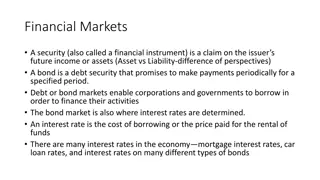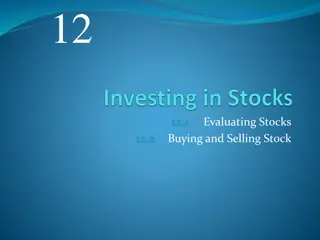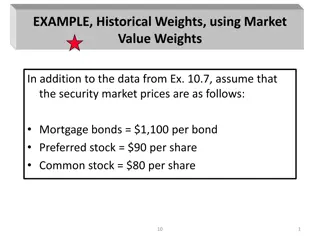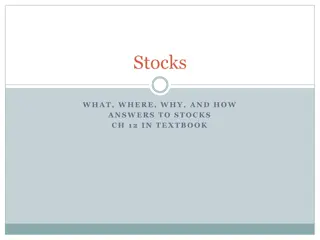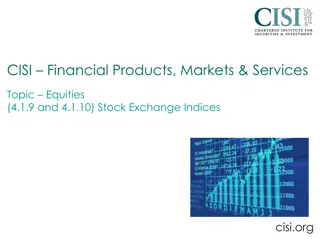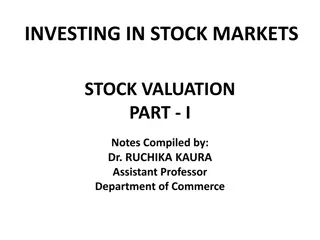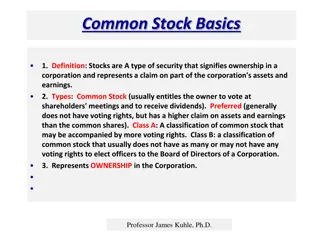
Indian Stock Market: Functions, Benefits, and Importance
Learn about the Indian stock market, secondary markets, and stock exchanges. Discover the functions, benefits, and importance of stock exchanges for investors and companies. Understand how stock exchanges support economic development, capital formation, and investor protection in the financial market.
Download Presentation

Please find below an Image/Link to download the presentation.
The content on the website is provided AS IS for your information and personal use only. It may not be sold, licensed, or shared on other websites without obtaining consent from the author. If you encounter any issues during the download, it is possible that the publisher has removed the file from their server.
You are allowed to download the files provided on this website for personal or commercial use, subject to the condition that they are used lawfully. All files are the property of their respective owners.
The content on the website is provided AS IS for your information and personal use only. It may not be sold, licensed, or shared on other websites without obtaining consent from the author.
E N D
Presentation Transcript
INDIAN STOCK MARKET
Secondary markets are those markets which deal in existing securities. Existing securities are those securities that have already been issued and are already outstanding. Secondary market consists of stock exchanges. Stock exchanges are self- regulatory bodies under the overall regulatory purview of the Govt. /SEBI. In the secondary market, the existing owner sells securities to another party. The secondary markets support the primary markets. The secondary market/n MEANING OF SECONDARY MARKETS
It is an organized market for the purchase and sale of securities of joint stock companies, government and semi-govt Bodies. It is the centre where shares, debentures and govt. Securities are bought and sold. In short these are market places where securities that have been listed there on may be bought and sold for either investment or speculation. MEANING OF STOCK EXCHANGE
(1) Liquidity (2) Continuous market for securities (3) Mobilization of savings (4) Capital formation (5) Economic development (6) Safeguards for investors FUNCTIONS OF THE STOCK EXCHANGE
BENEFITS OF STOCK EXCHANGE (A)Benefits to Investors: (1) The stock exchange plays the role of a friend, philosopher and guide to investors by providing information about the prices of various securities. (2) It offers a ready market for buying and selling securities (3) It increases the liquidity of the investors. (4) It safeguards the interests of investors through strict rule and regulations. (5) It enables the investors to know the present worth of these securities (6) It helps investors in making wise investment decisions providing useful information about the financial position the companies. (7) The holder of a listed security can easily raise loan pledging it as a collateral security.
(1) A company enjoys greater reputation and credit in market. Image of the company goes up. (2) A company can raise large amount of capital from different types of securities. (3) It enjoys market for its shares. (4) The market price for shares and debentures will be higher. Due to this the bargaining power of the company increases in the events of merger or amalgamation. (B) Benefits to Companies
(1) Stock exchange encourages people to sell and invest their savings in shares and debentures. (2) Through capital formation, companies to undertake expansion and modernization stock exchange enables (3) It helps the government in raising funds through sale of government securities. This enables the government to undertake projects of national importance and social value (4) It diverts the savings towards productive channels. (5) It helps in better utilization of the country's financial resources (6) It is an effective indicator of general economic conditions of a country (C) Benefits to Community and Nation:
LISTING OF SECURITIES: Securities that are listed are dealt with the stock exchange. For the purpose of listing of securities, a company has to apply to the stock exchange. The stock exchange will decide whether to list the securities of the company or not. If permission is granted by the stock exchange to deal with the securities therein, then such a company is included in stock exchange. This is the official trade list of technically known as listing of securities. In simple words, listing of securities means permission quote shares and debentures officially on the trading floor on the stock exchange. Listing of securities refers to the sanction of the right to trade the securities on the stock exchange. In short, listing means admission of securities to be traded on the stock exchange. If the securities are not listed, they are not allowed to be traded on the stock exchange.
(1) To ensure proper supervision and control of dealings insecurities (2) To protect the interests of shareholders and the investors (3) To avoid concentration of economic power. (4) To assure marketing facilities for the securities. (5) To ensure liquidity of securities. (6) To regulate dealings in securities. OBJECTIVES OF LISTING:
(A)Benefits to Company: (1) It provides continuous market for securities (securities include shares, debentures, bonds etc. (2) It enhances liquidity of securities. (3) It increases goodwill of the company (4) Companies can easily raise capital (5) It gives some tax advantage to the company. BENEFITS OF LISTING:
(1) It provides safety of dealings. (2) It facilitates quick clearance of securities in times of need. This means that listing enhances the liquidity of securities. (3) Listed securities command higher collateral value for the purpose of bank loans (4) It provides an indirect check against manipulation by the management. (B) Benefits to Investors
(1) It leads to speculation and generation of hot money. (2) Sometimes listed securities subjected to wide are fluctuations in their value. This may degrade the company's reputation (3) It discloses vital information such as dividends and bonus declared etc. to competitors. (4) Company has to spend heavily in the process of placing the securities with public DISADVANTAGES OF LISTING
(1) Memorandum and Articles. (2) Copies of all prospectuses or statements in lieu of prospectuses. (3) Copies of balance sheets, audited accounts, agreements with promoters, underwriters, brokers etc. (4) Letters of consent from SEBI. (5) Details of shares and forfeited. (6) Details of bonus issues and dividends declared. (7) History of the company in brief. (8) Agreement with managing director etc. (9) An undertaking regarding compliance with the provisions of the Companies Act and Securities Contracts (Regulation Act) PROCEDURE OF LISTING ON STOCK EXCHANGE
(1) Bulls: Bulls are those investors or the brokers for that matter who believe that the share price is going to upwards, they ever they are going to continuously going to be rise as such, there will be little optimist that the share price will going to move up. (2) Bears: Bears are some those investors, those brokers, those participants who say that the share price is going to actual fall, they have got pessimistic, expected the share price going to fall. (3) Stags: Stags are some people who are not interested in the market or so they are independent, whether there as a bear bulls market or bears market, going up or market is coming down. PLAYERS IN STOCK MARKET
(1) Indexes are constructed to measure the price movements of shares, bonds and other types of instruments in market. (2) A stock market index is a measurement which indicates nature, direction and the extent of day to day fluctuations in the stock prices (3) It is a stock market index is a barometer of market behavior (4) It functions as an indicator of the general economic scenario of a country. If stock market indices are growing, it indicates that the overall general economy of country is stable if however the index goes down it shows some trouble in economy. STOCK INDICES (INDEXES)
(1) BSE Sensex. (2) S&P CNX Nifty. (3) S&P CNX 500. (4) BSE 500. (5) BSE 100.ALME (6) BSE 200/Dollex. (7) BSE IT. (8) BSE CG. (9) BSE FMCG. (10)S&P CNX Defty. Stock Indices in India:
Jobbers: buy on their own names Commission brokers: on behalf of clients Tarawaniwalas: like jobbers they trade to brokers Sub-brokers: agents of stock brokers Arbitrageurs: trade in different market Authorized clerks: appointed by stock brokers MEMBERS IN A STOCK EXCHANGE
Bombay Stock Exchange (BSE): Established in 1875, BSE Ltd. (formerly known as Bombay Stock Exchange Ltd.), is Asia's first Stock Exchange and one of India's leading exchange groups. Over the past 137 years , BSE has facilitated the growth of the Indian corporate sector by providing it an efficient capital-raising platform. More than 5000 companies are listed on BSE making it World's No. 1 exchange in terms of listed members. The Companies listed on BSE Ltd command a total market capitalization of USD 1.32 Trillion as of January 2013. It is also one of the world's leading exchanges (3rd largest in December 2012) for Index options trading (Source: World Federation of Exchanges). MAJOR STOCK EXCHANGES IN INDIA
Launch a special platform for trading in SME securities. Introduce Equity Derivatives. Launch a Free Float Index-S&P BSE SENSEX. Launch Exchange Enabled Internet Trading Platform. Obtain ISO certification for a stock exchange. Exclusive facility for financial training- BSE Institute Ltd. Launch its website in Hindi and regional languages Host the popular opening-bell ceremony in Indian capital markets. Become securities market infrastructure member of SWIPT in India and provide corporate actions to custodians in ISO15022 format. Launched S&P BSE SENSEX Realized S&P BSE Volatility(REALVOL) Index in Nov 2010. Achievements of BSE:
The Bolt system has enabled the exchange to meet the following objective: Reduce and eliminate operational inefficiencies inherent in manual systems. Increases trading capacity of the stock exchange. Improve market transparency, eliminate unmatched trades and delayed reporting. Promote fairness and speedy matching. Provide for on-line and off-line monitoring, control and surveillance of the market. Smooth market operations using technology while retaining he flexibility of conventional trading practices. Set up various limits, rules and controls centrally. Provide brokers with their trade data on electronic media to interface with the Broker's Back Office system.
(1) The National Stock Exchange (NSE) is India's leading stock exchange covering various cities and towns across the country (2) NSE was set up by leading institutions to provide a modern fully automated screen-based trading system with national reach. The Exchange has brought about unparalleled safety and market transparency, speed & efficiency, integrity (3) It has set up facilities that serve as a model for the securities industry in terms of systems, practices and procedures. (4) NEAT NSE uses satellite communication expertise to strengthen contribution from around 400 Indian cities. It is one of the biggest VSAT incorporated stock exchange across the world. National Stock Exchange (NSE):1992
Over the Counter Exchange of India (OTCEI): The OTCEI was incorporated in October, 1990 as a company under the Companies Act 1956. It became fully operational in 1992 with opening of a counter at Mumbai. It is recognized by the Government of India as a recognized stock exchange under the Securities Control and Regulation Act 1956. It was promoted jointly by the financial institutions like UTI, ICICI, IDBI, LIC, GIG, SBI, IFCI, etc. The Features of OTCEL are: OTCEI is a floorless exchange where all the activities are fully computerized. Its promoters have been designated they alone are entitled to sponsor as sponsor members and company for listing there. Trading on the OTCEI takes place through network of computers or OTC dealers located at different places within city and even across the cities. These computers the same allow dealers to quote, query & transact through a central OTC computer using the telecommunication links. OTCEI deals in equity shares, preference shares, bonds, debentures and warrants.










